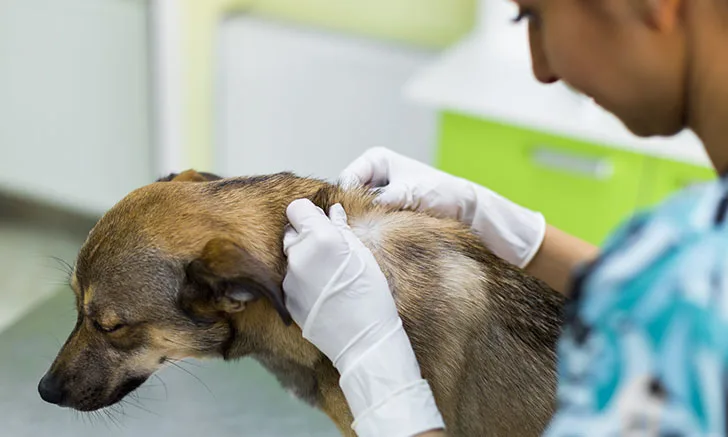Practical Approach to Canine Pruritus

Sponsored by Zoetis
Allergic skin and ear disease are consistently at the top of the list of the most common presenting complaints to veterinary clinics.1 Pruritus affects both patient and owner quality of life and can be detrimental to the human–animal bond. Achieving an appropriate diagnosis of the underlying cause of pruritus, as well as managing clinical signs, is essential to positive case outcomes.
The Diagnostic Approach
The first step in achieving a diagnosis in the pruritic patient is obtaining a thorough history, including information regarding diet, parasite prevention, seasonality of clinical signs, and current or past treatment strategies.
A complete physical examination should be performed, taking note of the severity and distribution of skin lesions, evidence of parasites or infection, and/or signs of systemic disease. As a differential diagnosis list is created, a diagnostic plan should be initiated. The minimum database for a pruritic patient should include skin scraping, skin cytology (impression smears or swabs), ear cytology, mineral oil prep for mites, flea combing, and fecal analysis.
Once ectoparasites are ruled out, the information provided by cytology often drives critical treatment decisions for the patient. It is essential to accurately diagnose secondary infections and support good antimicrobial stewardship.2 Despite the value of cytology, only 41% of dogs and 35% of cats presenting for pruritus have cytology performed during their visit.3 Barriers to cytology include cost, time commitment, and lack of veterinary team comfort in interpreting results.3
The Vetscan Imagyst™ is a diagnostic tool that harnesses AI technology to provide accurate in-clinic cytologic results.4 After preparing a sample slide, the Vetscan Imagyst scans the slide and provides identification of yeast, bacteria, and inflammatory cells on impression smears, skin swabs, and ear swabs, helping veterinary teams overcome the challenges of cytology interpretation while saving valuable time in the clinic.3 If the cytologic findings do not match the clinical picture or if the veterinarian has further questions regarding the AI results, a request for review by a board-certified clinical pathologist can be added for an additional fee.
The Therapeutic Approach
Keeping in mind that pruritus can have serious impacts on quality of life, controlling pruritus during a patient’s diagnostic investigation is of primary importance. This is particularly crucial in cases with a lengthy diagnostic approach, such as during management of secondary infections and food trials. Apoquel® (oclacitinib tablet), an oral tablet for dogs, provides fast allergic itch relief without interfering with most diagnostic tests.5 This can help improve the immediate quality of life of the pet and owner and make the owner more likely to adhere to a diagnostic plan.
Rechecks
Recheck examinations, including recheck cytology, are important to ensure full resolution of infection. If pruritus is not controlled after infection resolves, next step diagnostics, including food trials and allergy testing, should be pursued.
Conclusion
Diagnostic testing in pruritic patients provides critical information that can be used to achieve a definitive diagnosis and lead to resolution of clinical signs. Thanks to advancing technology, the Vetscan Imagyst aids in the diagnosis and monitoring of skin and ear infections with rapid and accurate in-clinic cytology.4
Apoquel Indications
Control of pruritus associated with allergic dermatitis and control of atopic dermatitis in dogs at least 12 months of age.
Apoquel Important Safety Information
Do not use Apoquel in dogs less than 12 months of age or those with serious infections. Apoquel may increase the chances of developing serious infections, and may cause existing parasitic skin infestations or pre-existing cancers to get worse. Consider the risks and benefits of treatment in dogs with a history of recurrence of these conditions. New neoplastic conditions (benign and malignant) were observed in clinical studies and post-approval. Apoquel has not been tested in dogs receiving some medications including some commonly used to treat skin conditions such as corticosteroids and cyclosporines. Do not use in breeding, pregnant, or lactating dogs. Most common side effects are vomiting and diarrhea. Apoquel has been used safely with many common medications including parasiticides, antibiotics and vaccines. Read the full product information summary here.
VTS-01113
